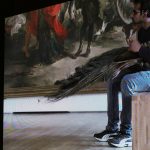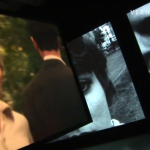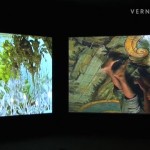Like most of the museums and collections in Miami, the Bass Museum of Art in Miami Beach opened a new exhibition on the occasion of Art Basel Miami Beach week. This year the museum presented the exhibition Isaac Julien / Creative Caribbean Network. The show features the US premiere of Isaac Julien’s installation Ten Thousand Waves along with films and photographs from the earlier series Paradise Omeros, Baltimore and Vagabondia. The exhibition runs through March 6, 2011.
Isaac Julien’s nine-screen film installation “Ten Thousand Waves” had its world premiere at the Sydney Biennale in May 2010. It was conceived and made over four years, and shot on location in China. For the project, Isaac Julien collaborated with the Chinese artists Maggie Cheung, Zhao Tao, Wang Ping, Gong Fagen, Yang Fudong, and Zhao Xiaoshi. The film’s original musical score is by Jah Wobble and The Chinese Dub Orchestra and contemporary classical composer Maria de Alvear. The work poetically weaves together stories linking China’s ancient past and present. Through an architectural installation, the work explores the movement of people across countries and continents and meditates on unfinished journeys. Press release and photo gallery after the jump.
Isaac Julien Creative Caribbean Network at Bass Museum of Art, Miami Beach. Opening reception, December 1, 2010.
> Right-click (Mac: ctrl-click) this link to download Quicktime video file.
From the press release:
Filmed on location in the ravishing and remote Guangxi province and at the famous Shanghai Film Studios and various sites around Shanghai, TEN THOUSAND WAVES combines fact, fiction and film essay genres against a background of Chinese history, legend and landscape to create a meditation on global human migrations. Through formal experimentation and a series of unique collaborations, Julien seeks to engage with Chinese culture through contemporary events, ancient myths and artistic practice.
The original inspiration for TEN THOUSAND WAVES was the Morecambe Bay tragedy of 2004, in which 23 Chinese cockle-pickers died. In response to this event, Julien commissioned the poet Wang Ping to come to England and write Small Boats, a poem that is recited in the work. In the successive years, Julien has spent time in China slowly coming to understand the country and its people’s perspectives and developing the relationships that have enabled him to undertake this rich and multifaceted work.
Through conversations with academics, curators and artists both in China and the UK, Julien uncovered a symbolic body of material which he has used to create a work that explores modern and traditional Chinese values and superstitions. These are encapsulated in a fable about the goddess Mazu (played by Maggie Cheung) that comes from Fujian Province, from where the Morecambe Bay cockle-pickers originated. The Tale of Yishan Island tells the tale of 16th Century fishermen lost and in danger at sea. At the heart of the legend is the goddess figure who leads the fishermen to safety. Using this fable as a starting point Julien deftly draws on this story and the poignant connection between it and the 21st Century tragedy of Chinese migrants who died struggling to survive in the North of England.
Following ideas surrounding death, spiritual displacement, and the uniquely Chinese connection with “ghosts” or “lost souls”, the film links the Shanghai of the past and present, symbolising the Chinese transition towards modernity, aspiration and affluence. Here, Julien employs the visual language of ghost stories, with recurrent figures and images appearing and disappearing. Mazu’s spectral figure traverses time and space, serving as a guide through the interlocking strands of the work. Mirroring the goddess of the fable, a ghostly protagonist (Zhao Tao) leads us through the world of Shanghai cinema via the Shanghai-
Film Studio, to a restaging by Julien of scenes from the classic Chinese film The Goddess (1934), and finally to the streets of Modern and Old Shanghai.










